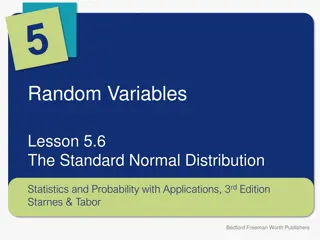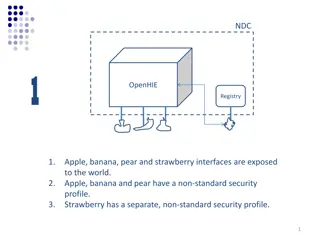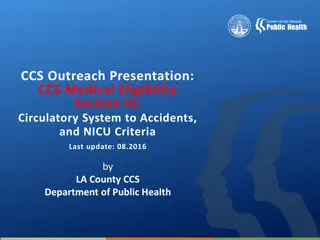Understanding 95% Confidence Intervals in Statistics
Confidence intervals are a key concept in statistics that provide a range within which the true value of an estimate is likely to fall. This video series explores the interpretation of 95% CIs, compares them to standard error and standard deviation, and explains how sample size and standard deviatio
2 views • 8 slides
Ohio Collaborative Standard for Vehicular Pursuit Certification Program 2023
The Ohio Collaborative Community-Police Advisory Board adopted the State of Ohio Standard for Vehicular Pursuit in 2020 to address the risks and dangers associated with vehicle pursuits. This standard aims to govern law enforcement agencies in defining pursuits, criteria for initiation, evaluating c
3 views • 46 slides
Ohio Collaborative Standard for Body-Worn Cameras
The Ohio Collaborative Standard for Body-Worn Cameras outlines guidelines for law enforcement agencies regarding the use of body-worn cameras. It emphasizes the importance of clear policies, accountability, and privacy considerations. Adopted in 2016, this standard aims to enhance trust between poli
0 views • 29 slides
Ohio Collaborative Standard: Investigation of Employee Misconduct
Ohio Collaborative Standard focuses on the investigation of employee misconduct in law enforcement agencies, emphasizing the importance of procedural justice, public respect, and comprehensive investigation processes. It outlines the purpose, learning objectives, and the establishment of written pol
0 views • 29 slides
Understanding Normal Conditions of Use for New Propulsion Technologies in Vehicles
Explore the concept of normal conditions of use for vehicles with new propulsion/charging technologies. Learn how to assess and define normal conditions, operating modes, worst case scenarios, and overview of current technologies. Discover the approach to measure normal conditions and testing requir
1 views • 8 slides
Understanding Boolean Algebra: Duality Theorem, De-Morgan's Law, and Don't Care Conditions
Boolean algebra concepts such as the Duality Theorem, De-Morgan's Law, and Don't Care Conditions are essential for digital circuit design. The Duality Theorem states the relationship between a Boolean function and its dual function by interchanging AND with OR operators. De-Morgan's Law helps find t
0 views • 10 slides
Understanding Standard Form and Numbers Conversion
Explore the concept of standard form, learn how to write numbers concisely, and practice converting numbers to and from standard form through helpful examples and exercises. Enhance your skills in dealing with big and small numbers efficiently.
2 views • 16 slides
Understanding Social Determinants of Health
Chronic conditions like heart disease and cancer have multiple causes, not all biological. Social epidemiology studies the social distribution of health, morbidity, and mortality risk influenced by social status and conditions. Factors such as age, gender, race, socioeconomic status, and social cond
0 views • 32 slides
Standard Costing: Understanding Variances in Actual vs. Budgeted Costs
Explore the concept of standard costs, variance analysis, and the importance of investigating variances in actual vs. budgeted costs. Learn to calculate and interpret material and labor variances, overhead variances, and participate in a case study to apply learned concepts. Understand the developme
2 views • 52 slides
Social Impact of the Industrial Revolution: Living Conditions, Urbanization, and New Social Classes
The Industrial Revolution had a profound social impact, bringing contrasting living conditions for entrepreneurs and workers. While entrepreneurs reaped riches, workers faced poverty and harsh living conditions. Urbanization accelerated as people moved to cities for work, leading to the growth of ne
1 views • 20 slides
Issues with SCS Operation in IEEE 802.11be Standard
The document discusses technical issues related to the SCS (Spatial Channel Sharing) operation in the IEEE 802.11be standard. It highlights inconsistencies in the standard regarding parameterized QoS requirements, mixing of traffic streams with different QoS needs, and challenges in prioritizing SCS
0 views • 15 slides
Understanding Motion and Measurement of Distances in Science at Sainik School Gopalganj
Explore the concepts of motion and measurement of distances in science as taught by Dr. A.K. Choubey at Sainik School Gopalganj. Discover the development of means of transport, different measurement methods like non-standard and standard measures, the significance of measurement, and the Internation
1 views • 16 slides
Understanding English Conditional Sentences
Explore the world of English conditional sentences, covering real conditions, unreal conditions in the present, and unreal conditions in the past. Learn about different types of conditions, their forms, and examples to grasp the concept thoroughly.
2 views • 24 slides
Indian Accounting Standard 2: Inventories Overview
This article provides an overview of Indian Accounting Standard 2 (IAS 2) on inventories. It covers the objectives, scope, definitions, and measurement of inventories at the lower of net realizable value or cost of purchase. The standard applies to all inventories except financial instruments and bi
2 views • 17 slides
Evolution of DICOM Standard for Radiation Therapy
The DICOM Standard has evolved significantly over the years to address the complex needs of radiation therapy in cancer treatment. The 2nd Generation DICOM RT introduces key principles, design approaches, and workflow improvements to enhance efficiency and safety in radiotherapy. Stakeholders in the
0 views • 26 slides
Understanding Standard Deviation, Variance, and Z-Scores
Explore the importance of variation in interpreting data distributions, learn how to calculate standard deviation, understand z-scores, and become familiar with Greek letters for mean and standard deviation. Discover the significance of standard deviation in statistical analysis and the difference b
1 views • 18 slides
Understanding the Standard Normal Distribution in Statistics
Exploring the significance of normal distributions in statistics, this lesson covers the 68-95-99.7 rule, using Table A to find probabilities and z-scores, properties of normal curves, and the standard normal distribution. Key concepts include the mean, standard deviation, and how to standardize var
4 views • 9 slides
Understanding Normal Distribution in Probability
Explore the properties and characteristics of the normal distribution, including the mode, symmetry, inflection points, and the standard normal distribution. Learn how to use standard normal tables to find probabilities and areas under the curve. Practice using examples to calculate probabilities ba
1 views • 35 slides
Workplace Exposure Standard for Silica Dust in Stone Benchtop Fabrication
Reduction in workplace exposure standard for respirable crystalline silica dust has been implemented, halving the national standard to 0.05 mg/m3. The new standard aims to protect workers in stone benchtop fabrication businesses from serious lung diseases caused by breathing in silica dust. Employer
1 views • 8 slides
Health and Disability Services Standard NZS 8134:2021 Update Overview
The session discusses the updated Health and Disability Services Standard NZS 8134:2021, highlighting changes from the 2008 edition, implementation details, and criteria application. The standard aims to enhance service quality and features key sections addressing rights, workforce, wellbeing pathwa
5 views • 20 slides
Discussion on Proposed Nomenclature for IEEE 802.11ba Standard
This document presents a discussion on the proposed nomenclature for the IEEE 802.11ba standard draft amendment, highlighting the need for clarity and consistency in terminology to avoid confusion and specification issues. Various new terms and definitions are suggested for different types of device
0 views • 13 slides
Understanding Measures of Variability: Variance and Standard Deviation
This lesson covers the concepts of variance and standard deviation as measures of variability in a data set. It explains how deviations from the mean are used to calculate variance, and how standard deviation, as the square root of variance, measures the average distance from the mean. Degree of fre
1 views • 26 slides
Understanding Co-occurring Mental and Physical Health Conditions
Co-occurring mental and physical health disorders are prevalent and require an integrative multidisciplinary approach for effective assessment and treatment. This holistic approach helps address the complexity of managing multiple disorders in an integrated healthcare setting. Through a multi-direct
1 views • 37 slides
Understanding Standard Deviation in National 5 Mathematics
Standard deviation measures the spread of data around the mean, indicating how close or far apart values are from the average. This concept is crucial in analyzing data variability and consistency, with lower values signifying data clustered around the mean and higher values indicating greater dispe
3 views • 12 slides
Comparison of Security Profiles in OpenHIE Registries
OpenHIE exposes interfaces with varying security profiles - non-standard in Scenario 1, standards-based in Scenarios 2 and 3. Scenario 1 requires managing multiple non-standard profiles, whereas Scenarios 2 and 3 facilitate plug-and-play with standard security protocols. Implications include ease of
4 views • 6 slides
Understanding Functional GI Disorders: A Comprehensive Overview
Functional GI disorders encompass a range of conditions affecting the gastrointestinal system, such as irritable bowel syndrome and disorders of the gut-brain interaction. These disorders are characterized by no structural abnormalities but are influenced by factors like motility disturbance, viscer
0 views • 42 slides
Update on Transmission System Performance Standard TPL-007-1 for Geomagnetic Disturbance Events
The status update covers the evolution of Reliability Standard TPL-007-1, focusing on the approval process, modifications required by FERC, and directives for NERC to enhance the standard. TPL-007-1 aims to assess vulnerability to geomagnetic disturbances and mandates corrective actions for non-comp
1 views • 11 slides
Exploring Physics Beyond the Standard Model through Atomic Spectroscopy
Unlocking the mysteries of physics beyond the Standard Model using atomic spectroscopy techniques. Delving into the shortcomings of the Standard Model and the quest for new physics through precision measurements of atomic forces and isotope shifts in heavy atoms. Highlighting the importance of the p
0 views • 47 slides
Understanding Inmate Health Care and Jail Conditions
Inmate health care and jail conditions are crucial aspects of the criminal justice system. This presentation delves into the treatment of prisoners, focusing on humane living conditions, safety, health care, and freedom rights. It emphasizes the importance of proper intake screening for medical and
1 views • 35 slides
Linking BIM and GIS Standard Ontologies with Linked Data
Introduction to the need for seamless data interpretation between Building Information Model (BIM) and Geographic Information System (GIS), focusing on aligning BIM and GIS standard ontologies for semantic interoperability. Addressing the challenges of data interoperability layers and the characteri
0 views • 15 slides
Medical Eligibility Criteria for Circulatory and Respiratory Diseases in CCS Outreach Presentation
This presentation outlines the medical eligibility criteria for circulatory and respiratory diseases under the California Children's Services (CCS) program. It covers conditions such as diseases of the circulatory system including endocardium, myocardium, and more, as well as respiratory conditions
0 views • 38 slides
Dealing with Multiple Related Conditions in Programming
When handling multiple related conditions in programming, using multiple `if` statements can become cumbersome. This guide explores how to efficiently manage such scenarios using branching techniques like `else-if` clauses. Learn about structuring your code to handle various conditions effectively w
0 views • 39 slides
Update on Lung Conditions Subcommittee of Advisory Board on Toxic Substances and Worker Health
The Lung Conditions Subcommittee conducted a review of 80 Part B cases related to various respiratory conditions in workers. The review highlighted common reasons for incorrect adjudications, such as misapplications of presumption criteria and unclear decisions on beryllium exposure. Conclusions rev
0 views • 21 slides
Analysis of Health Conditions Associated with Music Instrument Players
This analysis includes bar plots and PheWAS plots showcasing the number of diagnoses/conditions per Phecode category and conditions associated with various music instrument players such as string, percussionists, keyboard, brass, woodwind, vocalists, and child musicians aged 5 to 17. The plots revea
0 views • 9 slides
Understanding Hypocalcemia and Related Conditions
Hypocalcemia can be caused by various factors such as hypoparathyroidism, nonparathyroid conditions, and postoperative complications. Symptoms include muscle tetany, paresthesia, and seizures. Conditions like pseudohypoparathyroidism and congenital hypoparathyroidism also contribute to calcium imbal
0 views • 31 slides
Understanding Heart Disease: Causes, Symptoms, and Common Conditions
Heart disease, a prevalent health issue in the United States, encompasses various cardiovascular conditions like coronary artery disease and hypertension. It is a leading cause of death, often resulting from conditions that can lead to heart attacks or failure. Symptoms of heart conditions vary, fro
0 views • 28 slides
Inguinoscrotal Conditions in Infants and Children - Overview
This informative article discusses inguinoscrotal conditions in infants and children, including inguinal hernia, hydrocele, undescended testis, and acute scrotum. It covers the pathology, embryology, anatomy, prevalence, associated conditions, history, and examination related to these conditions. Th
0 views • 28 slides
Understanding Standard Molar Enthalpies of Formation
Formation reactions involve substances being created from elements in their standard states, with the enthalpy change known as the standard molar enthalpy of formation (Hf). This enthalpy represents the energy released or absorbed when one mole of a compound is formed from its elements in their stan
0 views • 13 slides
Rainbow-Inclusive Workplaces Standard: Promoting Diversity in Employment
The Rainbow-Inclusive Workplaces Standard (NZS 8200:2015) is a groundbreaking initiative in New Zealand, setting guidelines for organizations to create inclusive and safe workplaces for individuals of diverse sexual orientations and gender identities. The standard aims to address discrimination and
0 views • 30 slides
Understanding Standard Deviation and Standard Error of the Means
Standard deviation measures the variability or spread of measurements in a data set, while standard error of the means quantifies the precision of the mean of a set of means from replicated experiments. Variability is indicated by the range of data values, with low standard deviation corresponding t
0 views • 7 slides







































